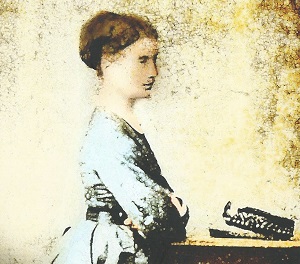
was buried in December 1871
(His daughter, Mary, and her husband, Neil Padden,
were later buried in the same grave).
Martin Davitt, father of Michael, the founder and chief organiser of the Irish Land League, died in Scranton, Pennsylvania, USA, one hundred and fifty years ago in December 1871 at the age of about fifty-seven. Martin was born in or around 1814 probably in the townland of Straide, County Mayo. As a young person, Martin was involved in a local agrarian secret society during the 1830s. Arising from these activities, he went to England for a period before returning to Straide to farm a small holding of land as a yearly tenant on a local estate. Martin, who probably attended a local hedge-school in his youth, was literate, bi-lingual, and a good reader, with a big interest in Irish and American history. He had a reputation as a good seanchaí, or storyteller, and in later years his son, Michael, remembered his narratives of the French landing in Killala Bay on 22 August 1798 to support a rebellion in Ireland, accounts of the Great Irish Famine, and other events in Irish history. These stories were to nurture strong patriotic feelings in Michael as well as a dislike of the then landlord system. In or around 1840, he married Catherine Kielty, from the parish of Turlough in County Mayo.
Four children were born to Martin and Catherine Davitt in Straide: Mary (1841), Michael (1846), Anne (1848) and Sabina (1850). (A fifth child was later born in England but did not survive.) They were christened in the nearby seventeenth-century church in Straide (which was refurbished and opened in 2000 to house the Michael Davitt Museum). The late 1840s was a difficult period in which to rear a young family. With the frugal subsistence of most families deteriorating each year, it was a major struggle to survive. Despite securing work on a local relief scheme and going to England as a seasonal migratory labourer for the summer of 1849, Martin Davitt was unable to pay off the arrears of rent which had accumulated during the Great Famine. After being served with an ejectment notice in 1849, the Davitt family were evicted, probably in October 1850, as part of the ‘great clearances.’ This involved the landlord’s agents forcing in the door of their home with a battering-ram, putting the family out on the road, and knocking the house, an unforgettable experience for any family.
The family went to the workhouse in Swinford, which they hated doing, but when Catherine Davitt was told that male children over three years of age had to be separated from their mothers, she promptly took her family away after one hour.
Sharing the fate of many thousands of Irish dispossessed by the famine, the Davitt family emigrated to Haslingden, a small textile town in Lancashire, about twenty-seven kilometres north of Manchester. They were transported to Dublin by another family from the vicinity of Straide who were going by horse and cart. They then crossed to Liverpool and stayed with some friends for a few days before making the twenty-seven kilometre journey to Haslingden by foot. The Davitts stayed with friends in Wilkinson Street until they were able to rent a house of their own at a place called Rock Hall in Haslingden. It was in Rock Hall that their fifth child and Michael’s only brother, James, was born in June 1853 (he died two years later). Martin’s first job was selling fruit from door to door, and he later became a labourer.
After Michael became involved in Fenian activities, he persuaded his parents and sisters to emigrate the United States. It was their wish to return to Ireland if they could make a living there, but acceding to Michael’s pressure they decided to cross the Atlantic. Preceded by their daughters, Martin and Catherine Davitt sailed from Liverpool and arrived in New York on 13 April 1870, and from there went to Scranton. (They were never to see Ireland or England again, which was the experience of almost all Irish emigrants at that time.) Shortly after their departure, Michael was imprisoned for his Fenian involvement. Of all that Michael endured in prison, his most depressing experience was when he learned of his father’s death in December 1871. Martin Davitt was buried in the Padden family plot (his son-in-law’s family), number 24, section D1, at the Cathedral Cemetery, Oram Boulevard, Scranton, Pennsylvania.
Exploring Mayo by Bernard O’Hara is now available Worldwide as an eBook for the amazon Kindle application.
The print version of Bernard O’Hara’s book Exploring Mayo can be obtained by contacting www.mayobooks.ie.
www.mayobooks.ie also sell the print versions of Killasser – Heritage of a Mayo Parish , Anseo and Davitt.
Bernard O’Hara’s book entitled Killasser: Heritage of a Mayo Parish is now on sale in the USA and UK as a paperback book at amazon.com, amazon.co.uk or Barnes and Noble
It is also available as an eBook from the Apple iBookstore (for reading on iPad and iPhone), from Amazon.com and Amazon.co.uk (Kindle & Kindle Fire) and from Barnesandnoble.com (Nook tablet and eReader).
An earlier publication, a concise biography of Michael Davitt, entitled Davitt by Bernard O’Hara published in 2006 by Mayo County Council , is now available as Davitt: Irish Patriot and Father of the Land League by Bernard O’Hara, which was published in the USA by Tudor Gate Press (www.tudorgatepress.com) and is available from amazon.com and amazon.co.uk. It can be obtained as an eBook from the Apple iBookstore (for reading on iPad and iPhone), from Amazon.com and Amazon.co.uk (Kindle & Kindle Fire) and from Barnesandnoble.com (Nook tablet and eReader).

